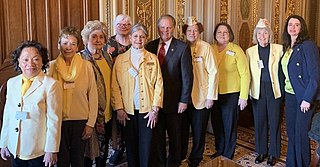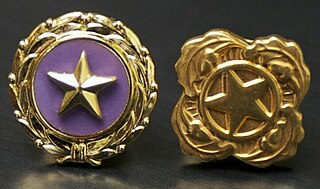
The national flag of the United States, often referred to as the American flag or the U.S. flag, consists of thirteen equal horizontal stripes of red alternating with white, with a blue rectangle in the canton, referred to as the union and bearing fifty small, white, five-pointed stars arranged in nine offset horizontal rows, where rows of six stars alternate with rows of five stars. The 50 stars on the flag represent the 50 U.S. states, and the 13 stripes represent the thirteen British colonies that declared independence from Great Britain, which they obtained in their victory in the American Revolutionary War.

The Legion of Merit (LOM) is a military award of the United States Armed Forces that is given for exceptionally meritorious conduct in the performance of outstanding services and achievements. The decoration is issued to members of the eight uniformed services of the United States as well as to military and political figures of foreign governments.

American Gold Star Mothers, Inc. (AGSM), is a private nonprofit organization of American mothers who lost sons or daughters in service of the United States Armed Forces. It was originally formed in 1928 for mothers of those lost in World War I, and it holds a congressional charter under Title 36 § 211 of the United States Code. Its name came from the custom of families of servicemen hanging a banner called a service flag in the windows of their homes. The service flag had a star for each family member in the Armed Forces. Living servicemen were represented by a blue star, and those who had lost their lives in combat were represented by a gold star.

The Honorable Service Lapel Button, colloquially called "Ruptured Duck" by the members of the military, was a lapel button awarded for honorable Federal military service between 1925 and 1946. The award, designed by Anthony de Francisci, was issued for wear on the left lapel of civilian clothing upon discharge.
Gold Star mothers are women entitled to display a gold star on a service flag as the mother, stepmother, adoptive mother or foster mother of a United States Armed Forces member that died while engaged in action against an enemy recognized by the Secretary of Defense.

The Air Medal (AM) is a military decoration of the United States Armed Forces. It was created in 1942 and is awarded for single acts of heroism or meritorious achievement while participating in aerial flight.

A badge is a device or accessory, often containing the insignia of an organization, which is presented or displayed to indicate some feat of service, a special accomplishment, a symbol of authority granted by taking an oath, a sign of legitimate employment or student status, or as a simple means of identification. They are also used in advertising, publicity, and for branding purposes. Police badges date back to medieval times when knights wore a coat of arms representing their allegiances and loyalty.
Officer Cadet is a rank held by military cadets during their training to become commissioned officers. In the United Kingdom, the rank is also used by members of University Royal Naval Units, University Officer Training Corps and University Air Squadron; however, these are not trainee officers with many not choosing a career in the armed forces.
The World War I Victory Medal was a United States service medal designed by James Earle Fraser of New York City under the direction of the Commission of Fine Arts.

In military organizations, the practice of carrying colours, standards, flags, or guidons, both to act as a rallying point for troops and to mark the location of the commander, is thought to have originated in Ancient Egypt some 5,000 years ago. The Roman Empire also made battle standards reading SPQR a part of their vast armies. It was formalized in the armies of Europe in the High Middle Ages, with standards being emblazoned with the commander's coat of arms.

The Gold Star Wives of America (Gold Star Spouses) (GSW) is a private nonprofit organization formed before the end of World War II that provides support for surviving spouses and children of those who lost their lives due to military service Armed Forces of the United States.

Mess dress uniform is the most formal type of evening-wear uniform used by military personnel, police personnel, and other uniformed services members. It frequently consists of a mess jacket, trousers, white dress shirt and a black bow tie, along with orders and medals insignia. Design may depend on regiment or service branch, e.g. army, navy, air force, marines, etc. In modern Western dress codes, mess dress uniform is the supplementary alternative equivalent to the civilian black tie for evening wear. Mess dress uniforms are typically less formal than full dress uniform, but more formal than service dress uniform.
A rosette is a small, circular device that is typically presented with a medal. The rosettes are either worn on the medal to denote a higher rank, or for situations where wearing the medal is deemed inappropriate, such as on a suit. Rosettes are issued to those awarded a knighthood or damehood in a chivalric order, as well as state orders in nations such as Belgium, France, Italy and Japan, among others. Certain hereditary societies, such as the Society of Descendants of the Latin Kingdom of Jerusalem, as well as some fraternal orders issue rosettes to their members as well.
Support our troops is a slogan commonly used in the United States and Canada in reference to each country's military forces or troops. The slogan has been used during recent conflicts, including the Gulf War and the Iraq War.

Blue Star Mothers of America, Inc. (BSMA), is a private nonprofit organization in the United States that provides support for mothers who have sons or daughters in active service in the U.S. Armed Forces. It was originally formed during World War II. The name came from the custom of families of servicemen hanging a banner called a Service Flag in a window of their homes. The Service Flag had a star for each family member in the military. Living servicemen were represented by a Blue Star and those who had lost their lives were represented by a Gold Star. Until 2011, membership in the Blue Star Mothers was open to any woman living in America who has a son or daughter in the United States Armed Forces, or who has had a son or daughter in the U.S. Armed Forces who was honorably discharged.
The United States Code is the official compilation of the Federal laws of a general and permanent nature that are currently in force. Title 36 cover, "Patriotic and National Observances, Ceremonies, and Organizations."

The uniforms of the United States Air Force are the standardized military uniforms worn by airmen of the United States Air Force to distinguish themselves from the other services.

The Silver Star Families of America (SSFOA) is a 501(c) tax exempt organization dedicated to honoring and supporting wounded, ill and injured veterans of all branches of the armed forces of the United States of America. The organization was founded in 2004 by Steve and Diana Newton with the assistance of Joseph and Sharon Newton and the entire Newton family. It is not related to the military decoration designated the Silver Star.

A Gold Star Lapel Button in the United States is an official decoration authorized by an Act of Congress that is issued to the direct next of kin family members of service members who died in World War I, World War II, and subsequent armed hostilities in which the Armed Forces of the United States has been engaged. The Gold Star Lapel Button was established by Act of Congress, Public Law 80-306, in August 1947.
Service lapel button may refer to:






















